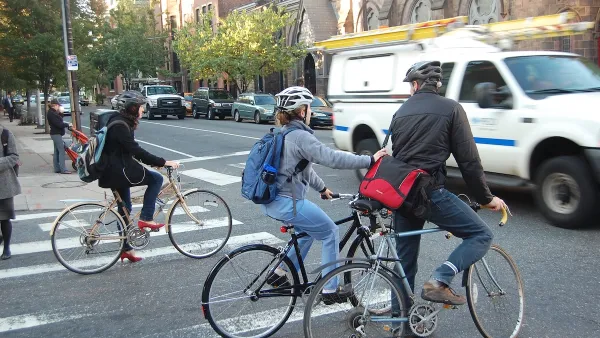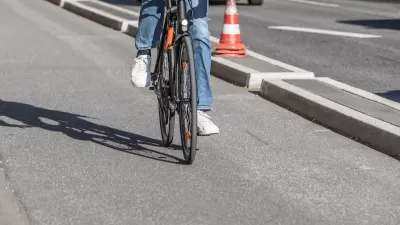A protected bike lane project in Downtown Los Angeles has ceded too much ground to cars, according to this opinion piece. If only it were the only example to choose from.
Matthew Fleischer, senior digital editor of the Opinion section of the Los Angeles Times and founder of its Livable City vertical, takes a strong position on Los Angeles bike infrastructure in a recent opinion piece.
In short: it isn't good enough.
Fleischer is mostly writing about the MyFigueroa complete streets project (see also the city's website for the MyFigueroa project), which in the decade since renderings that announced a potentially groundbreaking advancement in creating walkable and active public space (I wrote credulously on the subject in 2012) has transformed into a reality that Fleischer describes as a "monument to half-baked efforts."
Fleischer knows well the stakes of the choices made to provide people on bikes with safe facilities for riding around a city: he fell off his bike in Downtown Los Angeles and suffered a head injury.
"For bicyclists, walkers and, increasingly, scooter users, my story will hardly be surprising," writes Fleischer. "Yes, L.A. has bike lanes and pedestrian 'scrambles' and other 'alternative transit infrastructure' designed to protect vulnerable road users. But the infrastructure is spotty, badly maintained and confusing for drivers and cyclists. It can be almost as dangerous as no infrastructure at all."
Los Angeles' transit projects have also been accused of similar shortcomings in the past, as have projects in many other cities, and it's always a good time to consider whether a more complete commitment to allowing safe travel for more efficient modes would help deliver results that reflect ambitions.
FULL STORY: MyFigueroa is everything wrong with L.A.’s alternative transit efforts

Maui's Vacation Rental Debate Turns Ugly
Verbal attacks, misinformation campaigns and fistfights plague a high-stakes debate to convert thousands of vacation rentals into long-term housing.

Planetizen Federal Action Tracker
A weekly monitor of how Trump’s orders and actions are impacting planners and planning in America.

In Urban Planning, AI Prompting Could be the New Design Thinking
Creativity has long been key to great urban design. What if we see AI as our new creative partner?

Cal Fire Chatbot Fails to Answer Basic Questions
An AI chatbot designed to provide information about wildfires can’t answer questions about evacuation orders, among other problems.

What Happens if Trump Kills Section 8?
The Trump admin aims to slash federal rental aid by nearly half and shift distribution to states. Experts warn this could spike homelessness and destabilize communities nationwide.

Sean Duffy Targets Rainbow Crosswalks in Road Safety Efforts
Despite evidence that colorful crosswalks actually improve intersection safety — and the lack of almost any crosswalks at all on the nation’s most dangerous arterial roads — U.S. Transportation Secretary Duffy is calling on states to remove them.
Urban Design for Planners 1: Software Tools
This six-course series explores essential urban design concepts using open source software and equips planners with the tools they need to participate fully in the urban design process.
Planning for Universal Design
Learn the tools for implementing Universal Design in planning regulations.
Appalachian Highlands Housing Partners
Gallatin County Department of Planning & Community Development
Heyer Gruel & Associates PA
Mpact (founded as Rail~Volution)
City of Camden Redevelopment Agency
City of Astoria
City of Portland
City of Laramie




























